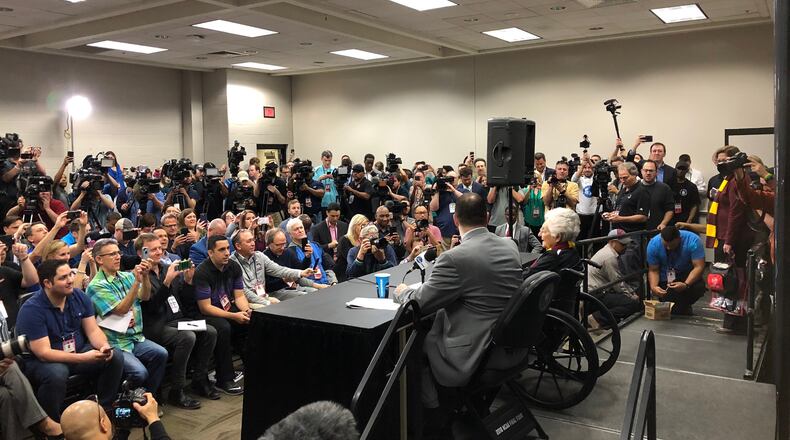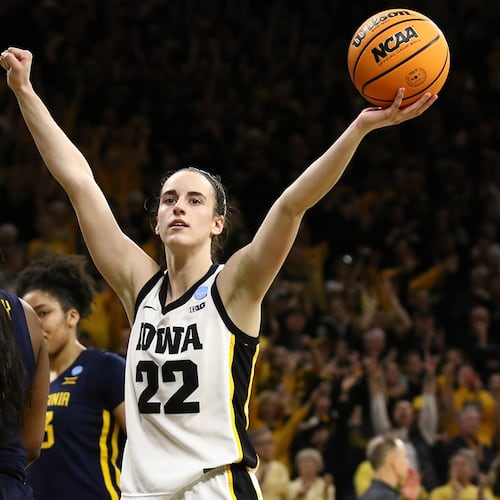Sister Jean Dolores Schmidt held an officially sanctioned mass interview at the Final Four on Good Friday. The room was literally SRO. Nobody had ever seen anything like it.
Said Porter Moser, who coaches Loyola-Chicago, the team for which Sister Jean, who’s 98, offers prayers and predictions: “Obviously Sister Jean’s press conference is still going on. Thus the open seats (at Moser’s session).”
Said Donte Ingram, who plays for the Ramblers: “Walking by (her breakout room), you would have thought she was one of us.”
Said Moser: “(Donte) said it looked like one of us. I thought it looked like Tom Brady at the Super Bowl.”
The point being: This really is Sister Jean’s Final Four.
It should be, ahem, a blessed event. There are no one-and-dones here. Of the four qualifying teams, only Kansas has been linked in any way to the ongoing FBI investigation, that involving a loan from an agent to the mother of former Jayhawk Josh Jackson. Villanova, considered a shining example of Doing It The Right Way, is the favorite. (Yes, this is also a very Catholic Final Four.) Loyola is only the fourth No. 11 seed to qualify, and it would be no real shock if the Ramblers beat Michigan – whose coach, John Beilein, is Catholic – on Saturday.
To top it off, this is Easter weekend in one of the NCAA’s favorite cities. As Sister Jean told her massive audience: “We’re going to a Good Friday service this afternoon. … We’re having a university Mass together on Easter Sunday – I said Easter Sunday because we hope to stay, and we’re confident enough we will – and one of our Jesuits is coming down to say the Mass for us.”
This is fun stuff. But just overhead, figuratively speaking, is the darkest cloud this sport has known since the NBA/ABA wars of the early 1970s, if not the point-shaving scandals of the ’50s.
In his state-of-the-association briefing Thursday, NCAA president Mark Emmert addressed the matter than has hung over this season: “Everybody had heard rumors about that kind of behavior and the business had swirled around everyone. But nobody had it displayed as starkly as it was in the findings of that (FBI) investigation. That caused all of us to say, ‘How do we take this very difficult and disturbing moment and turn it into something positive?’”
The committee Emmert commissioned to address the sport’s wrongs – it’s chaired by Condoleezza Rice, once the Secretary of State – will offer its recommendations at the end of April. Even Emmert doesn’t know what, if anything, is coming. But he offered this: “Everybody involved in college basketball recognizes this can’t continue the way it’s continuing.”
But how much can the often toothless NCAA really do? One-and-dones are a major issue, but one-and-done is function of the NBA’s age rule. At the heart of the FBI probe is money from shoe companies funneled to recruits through agents and AAU contacts, but what jurisdiction does the NCAA have over shoe companies and agents and the AAU? Said Eric Kaler, president of the University of Minnesota and chair of the NCAA’s Division I board of directors: “We realize that some of the recommendations are likely to be changes outside of our sole purview.”
Then: “We anticipate an engagement with the NBA and the (NBA) players association. We anticipate conversations with the AAU.”
Can such dialogue address the disconnect at the heart of college basketball – namely, that broadcast rights for this tournament command billions and coaches make millions, but the players are unpaid outside of scholarships and ancillary stuff?
Emmert: “The most fundamental principle … is whether or not we want to have college sports as it exists today – that’s student-athletes playing student-athletes – or whether we want to move toward a model where these are employees compensated, whether directly or indirectly, for their performance. And universities and colleges have consistently said they don’t want to have student-athletes become employees of a university.”
To recap: The NCAA president believes college basketball must change, but he and his member institutions don’t want it to change all that much. Emmert again: “I personally think there needs to be more room for individuals who want to pursue professional sports to be able to do that. … They ought to be provided that opportunity if they don’t want to go to college.”
Which sounded like the NCAA president wants the NBA to ditch its age rule and allow again for none-and-dones. That would be preferable to one-and-done – almost anything would be – but would it clean up college hoops? Would it curb the transfers that have become the collegiate version of the waiver wire?
Asked by Emmert how many players are transferring, NCAA vice president of basketball Dan Gavitt said, “Forty percent.” Think about that.
Again, this has been a mostly sunny Big Dance. Even Tony Bennett, whose Virginia team became the first No. 1 seed to lose to a No. 16, put on a happy face when receiving the Associated Press coach of the year award. “It was a heck of a season,” he said, “with a heck of a loss at the end.”
The NCAA champion will be crowned April 2. By the time May arrives, the sport could have embarked on initiatives that will help make the sport a better place – or it could, in grand NCAA style, have opted to do nothing much. This has been a heck of a tournament, but the bigger news will be made in the months ahead. Some of it could be grim.
Asked if God is a basketball fan, Sister Jean said: “He probably is. And He’s probably a fan more of the NCAA than the NBA.”
If that’s true, a bit of divine intervention would be most welcome.
About the Author
The Latest
Featured



